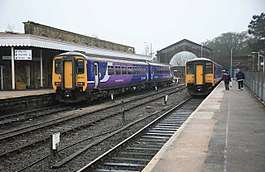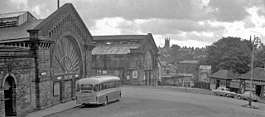Buxton railway station
Buxton railway station serves the town of Buxton in Derbyshire, England. It is managed and served by Northern. The station is 25 3⁄4 miles (41.4 km) south east of Manchester Piccadilly and is the terminus of the Buxton Line.
| Buxton | |
|---|---|
 A Class 156 and a Class 150/2 unit at Buxton station | |
| Location | |
| Place | Buxton |
| Local authority | High Peak |
| Coordinates | 53.261°N 1.913°W |
| Grid reference | SK059737 |
| Operations | |
| Station code | BUX |
| Managed by | Northern |
| Number of platforms | 2 |
| DfT category | E |
| Live arrivals/departures, station information and onward connections from National Rail Enquiries | |
| Annual rail passenger usage* | |
| 2014/15 | |
| 2015/16 | |
| 2016/17 | |
| 2017/18 | |
| 2018/19 | |
| History | |
| Original company | Stockport, Disley and Whaley Bridge Railway |
| Pre-grouping | London and North Western Railway |
| Post-grouping | London, Midland and Scottish Railway |
| 15 June 1863 | Station opened |
| National Rail – UK railway stations | |
| |
Facilities
The station is fully staffed, with the ticket office open on weekdays between 05:50 - 20:00, Saturdays 05:50 - 20:00 and Sundays 08:15 - 22:30. A self-service ticket machine is also available for use outside these times and for collecting pre-paid tickets. A payphone, waiting room and toilets are all provided in the main building, whilst platform 1 has a waiting shelter and bench seating. Train running details are offered via automatic announcements, CIS displays and timetable poster boards. Step-free access is available to both platforms from the main entrance.[1]
Services
Until May 2018, there was an hourly service daily (including Sundays) between Buxton and Manchester Piccadilly, taking about one hour. The service frequency was enhanced to about half-hourly in the morning and evening peaks. A limited number of trains worked through beyond Manchester, with trains to/from Blackpool North, Clitheroe, Barrow-in-Furness, Wigan North Western, Preston and Kirkby.[2]
From 21 May 2018, two trains per hour started running between Manchester and Buxton all day, one of which omits certain stations en route. The evening and Sunday service remains hourly and there are no longer any through trains to/from destinations north of Manchester.[3]
Platform 2 is the main platform for arrivals and departures. Platform 1 is a departure platform by shunt move, which is usually used in early mornings by the first trains of the day which have been stabled overnight or when attachment/detachment of a unit to/from a formation is required.
Future
Network Rail has proposed, in their North West RUS, installing a facing cross-over which will allow platform 1 to become fully operational as an arrival and departure platform. Doing this will reduce the number of shunt moves.
History
Two railways arrived in Buxton almost simultaneously in 1863. The Stockport, Disley and Whaley Bridge Railway, heavily promoted by the London and North Western Railway (LNWR), built its line from Manchester to Whaley Bridge and extended it to Buxton. Meanwhile, the Midland Railway extended the Manchester, Buxton, Matlock and Midlands Junction Railway from Rowsley. When the Midland extended its main line to New Mills in 1867, to bypass the LNWR, Buxton became a branch line from Millers Dale. The two railways planned separate stations, but the town's leaders were concerned that the railway would damage the character of the place and requested that they be built side-by-side, and be in keeping with the existing architecture of the town. Consequently, the LNWR and Midland station were given identical frontages designed by Joseph Paxton, each being built from local stone and having a wrought iron glazed train shed roof, fronted with identical half-circle fan widows.[4]
The Midland station closed in 1967, along with the line to Rowsley, and the site is now a roadway. However, the line through Dove Holes Tunnel from Chinley is still used for freight, such as limestone from Tunstead, along with the old Midland branch into Buxton and part of the old Ashbourne Line (closed to passengers in October 1954), which remains in use to serve a lime works at Dowlow and the quarry at Hindlow. These both join the main line just outside the station, where there also a number of sidings to allow trains to reverse. The bay platform formerly used by Ashbourne line trains and the connecting curve from it towards Dowlow have been removed, though it is still possible to trace its route. The LNWR station now handles local trains into Manchester, using its line through Dove Holes and Chapel-en-le-Frith.
The trainshed roof of the remaining station was removed, leaving only the fan window and it's stonework at the end of the station as a remnant. In 2009 the fan window was restored to its former glory.[4]
Accidents
- A runaway limestone train demolished the boiler room and gents toilet and damaged the porters' room in 1897, killing a passenger and injuring a porter.[5]
- A LNWR Class B boiler blew up in the station yard in 1921, killing the driver and fireman.[6]
Gallery
 Map showing the former extent of railways around Buxton.
Map showing the former extent of railways around Buxton. Station exterior in 1965. The present station is on the left, and the former Midland Railway station, now closed, is in the centre of the picture.
Station exterior in 1965. The present station is on the left, and the former Midland Railway station, now closed, is in the centre of the picture. London & North Western Railway Co fan window after restoration
London & North Western Railway Co fan window after restoration_in_1978.jpg) BR Class 104 DMU in the snow, 24 December 1978
BR Class 104 DMU in the snow, 24 December 1978 Buxton LNWR station signal box
Buxton LNWR station signal box
References
- Buxton station facilities National Rail Enquiries; Retrieved 17 May 2017
- Table 86 National Rail timetable, May 2017
- Table 86 National Rail timetable, May 2018
- "Buxton (Midland)". Disused Stations. Retrieved 21 May 2020.
- "What the railways are doing". Railway Magazine. September 1897. p. 282. Retrieved 15 December 2016.
- "Accident at Buxton on 11th November 1921 :: The Railways Archive". www.railwaysarchive.co.uk. Retrieved 15 December 2016.
- Radford, B., (1988) Midland Though The Peak Unicorn Books
- Pevsner, Nikolaus (1953) (revised Elizabeth Williamson 1978). The Buildings of England: Derbyshire. Penguin Books. ISBN 0-14-071008-6
External links
| Wikimedia Commons has media related to Buxton railway station. |
- Train times and station information for Buxton railway station from National Rail
- English Heritage – Buxton station frontage
| Preceding station | Following station | |||
|---|---|---|---|---|
| Terminus | Northern |